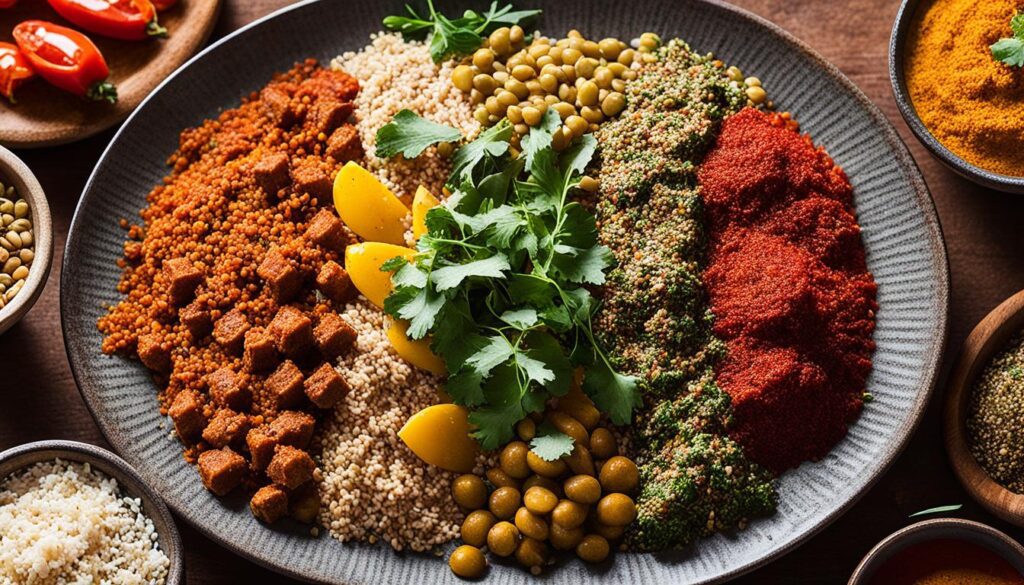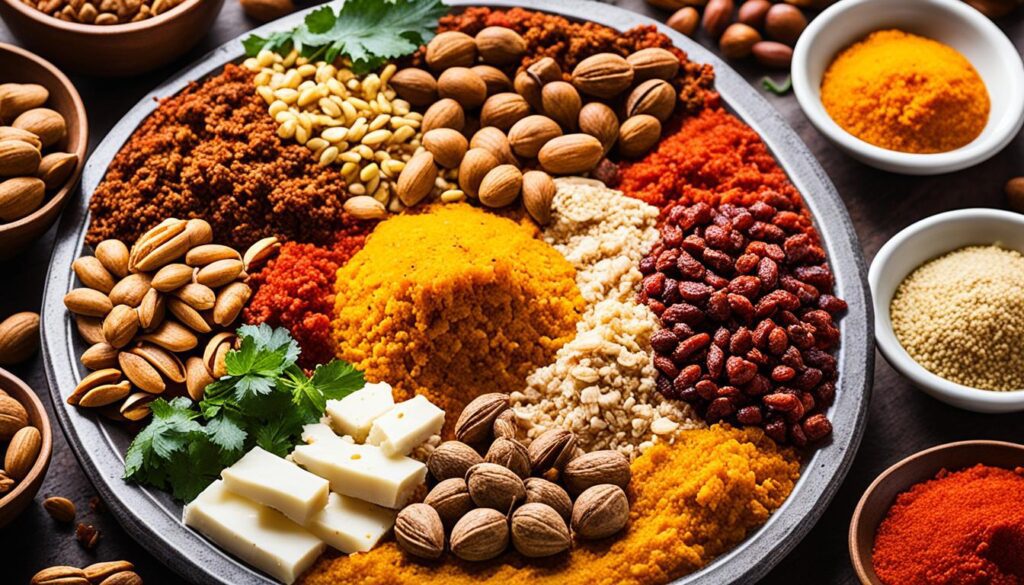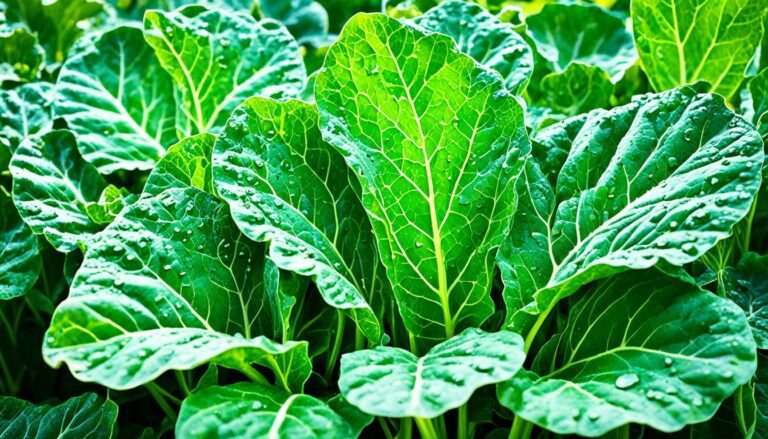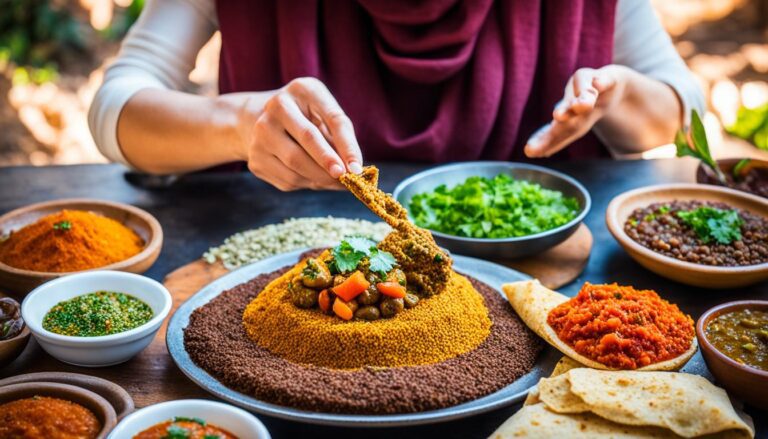Does Ethiopian Food Have Nuts?
Welcome to our exploration of Ethiopian cuisine! In this article, we will delve into the question that may have crossed your mind: Does Ethiopian food have nuts? Whether you have a nut allergy or are simply curious about the ingredients in this vibrant and flavorful cuisine, we’ve got you covered.
Join us as we uncover the nut content in popular Ethiopian dishes and provide a comprehensive guide to navigate this culinary journey. From discussing common ingredients and flavors to highlighting nut-free alternatives, we’ll provide valuable insights to enhance your understanding and enjoyment of Ethiopian cuisine.
So, let’s embark on this delicious adventure and discover the truth behind whether Ethiopian food incorporates nuts.
Key Takeaways:
- Ethiopian cuisine is rich and diverse, known for its unique flavors and spices.
- While some Ethiopian dishes do contain nuts, there are many nut-free options available.
- Nut allergies are prevalent in the United States, making it important to know the nut content in various cuisines.
- Ethiopian cuisine offers a variety of dishes that cater to individuals with nut allergies.
- Nut-free alternatives and modifications can be made to traditional Ethiopian recipes to accommodate dietary needs.
Introduction to Ethiopian Cuisine
Before we delve into the topic of nuts in Ethiopian food, let’s take a moment to introduce you to the wonderful world of Ethiopian cuisine. Ethiopian cuisine is known for its vibrant flavors, rich aromas, and diverse range of dishes. Rooted in tradition and deeply influenced by the country’s history and culture, Ethiopian food offers a unique culinary experience that is sure to tantalize your taste buds.
One of the hallmarks of Ethiopian cuisine is its use of aromatic spices and herbs, which add depth and complexity to the dishes. The use of these spices, along with traditional cooking techniques, creates a harmonious blend of flavors that is both bold and comforting.
In addition to spices, grains play a significant role in Ethiopian cooking. Injera, a sourdough flatbread made from teff flour, is a staple in Ethiopian cuisine and serves as the foundation for many meals. It is often used as a utensil to scoop up various stews and dishes, adding a unique touch to the dining experience.
Another distinctive feature of Ethiopian cuisine is its variety of vegetarian and vegan options. Lentils, chickpeas, and other legumes are commonly used to create hearty and flavor-packed dishes that cater to different dietary preferences.
Now that we’ve given you a glimpse into the fascinating world of Ethiopian cuisine, let’s continue our exploration and discover the presence of nuts in this intriguing culinary tradition.
Common Ingredients in Ethiopian Cuisine
When exploring the presence of nuts in Ethiopian food, it is crucial to familiarize ourselves with the common ingredients used in Ethiopian cuisine. By understanding the primary components of Ethiopian dishes, we can determine if nuts are frequently incorporated into these flavorful recipes.
Spices
In Ethiopian cuisine, spices play a fundamental role in creating the distinct flavors that make this cuisine so unique. Spices such as berbere, a fiery blend of chili peppers, garlic, ginger, and various spices, are commonly used in stews and grilled meats. Mitmita, a spicy mix of chili peppers and other spices, is often used to season dishes.
Grains
The Ethiopian diet heavily relies on grains, particularly teff, which is native to the country. Teff is a tiny grain used to make injera, a sourdough flatbread that serves as the base for many Ethiopian meals. Other grains like barley, wheat, and corn are also used in various dishes.
Legumes
Legumes, such as lentils, chickpeas, and split peas, are integral to Ethiopian cuisine. These protein-rich ingredients are often utilized in stews, soups, and vegetarian dishes, adding depth and texture to the overall culinary experience.
Other Staple Ingredients
Alongside spices, grains, and legumes, Ethiopian cuisine incorporates other staple ingredients that contribute to its robust flavors. Ingredients like garlic, ginger, onions, and tomatoes are commonly used for their aromatic properties and ability to enhance the taste of the dishes.
By understanding the common ingredients utilized in Ethiopian cuisine, we can now delve deeper into the presence of nuts and determine their prevalence in traditional Ethiopian dishes.

Nut Allergies: Prevalence and Concerns
Before we explore the presence of nuts in Ethiopian food, it is crucial to understand the prevalence of nut allergies in the United States and the potential risks they pose for individuals with allergies. Nut allergies are a significant concern, affecting millions of people nationwide. In fact, according to the Food Allergy Research and Education (FARE) organization, approximately 1 in 13 children in the U.S. have a food allergy, with nuts being one of the most common triggers.
For those with nut allergies, consuming nuts or even trace amounts of them can lead to severe and potentially life-threatening reactions. Allergic reactions to nuts can range from mild symptoms like itching or hives to more severe reactions such as difficulty breathing, swelling, and anaphylaxis. Due to the seriousness of nut allergies, it is essential for individuals with allergies to be aware of the ingredients in the foods they consume.

The image above provides visual representation regarding the concerns related to nut allergies.
Ethiopian Dishes without Nuts
If you have a nut allergy but still want to experience the exquisite flavors of Ethiopian cuisine, you’ll be delighted to know that there are plenty of delicious dishes that do not typically contain nuts. These nut-free Ethiopian delicacies allow individuals with allergies to savor the rich spices and unique combinations of flavors without any worries.
One such dish is Injera, a sourdough crepe-like bread that serves as the staple food in Ethiopian cuisine. Made from fermented teff flour, water, and salt, Injera is gluten-free and does not contain any nuts. It is often used to accompany a variety of stews and sauces, providing a tangy and slightly sour base to complement the other flavors.
Doro Wat is another popular Ethiopian dish that is typically nut-free. This flavorful chicken stew is made with marinated chicken cooked slowly in a rich blend of spices and served with Injera. The aromatic spices, including berbere (a fiery chili spice blend), garlic, ginger, and cardamom, give Doro Wat its distinctive taste without the addition of nuts.
For vegetarians or those looking for plant-based options, Misir Wat is an excellent choice. This spicy lentil stew is made with red lentils, onions, garlic, and Berbere. It is served with Injera or rice and is both satisfying and nut-free.
Beyaynetu: A Flavorful Vegetarian Platter
Beyaynetu is a traditional Ethiopian vegetarian platter that consists of a variety of dishes served together. It typically includes a mix of lentil stews, vegetable curries, and greens. This colorful and diverse platter offers a combination of flavors and textures without the inclusion of nuts. It’s an ideal option for those with nut allergies looking to taste a broad range of Ethiopian flavors in one sitting.
These are just a few examples of Ethiopian dishes that are nut-free. Many other traditional Ethiopian dishes like Kitfo, Tibs, and Shiro can also be enjoyed without nuts. Just make sure to inform your server about your allergies or check with the restaurant to ensure that the dishes are prepared nut-free.
Nut-Inclusive Ethiopian Dishes
Now, let’s dive into the world of Ethiopian cuisine and explore the delightful dishes that incorporate nuts as an ingredient. Nuts play a significant role in adding richness, texture, and flavor complexity to these traditional Ethiopian delicacies.
One popular example of a nut-inclusive Ethiopian dish is doro wat, a rich and spicy chicken stew. In this dish, ground or crushed peanuts are blended with traditional Ethiopian spices, creating a thick and flavorful sauce that complements the tender chicken. The peanuts not only add a nutty undertone but also enhance the overall richness of the dish.
Another famous Ethiopian dish that incorporates nuts is kitfo, which is made from minced raw or slightly cooked beef. In some variations of kitfo, finely ground toasted peanuts are added to the meat mixture, providing a unique nutty flavor and a satisfying crunch.
In addition to peanuts, other nuts like almonds and cashews can also be found in certain Ethiopian recipes. These nuts are often used in vegetarian dishes, such as lentil stews or vegetable curries, to add a creamy and nutty element to the flavor profile.
It’s important to note that while nuts are common in Ethiopian cuisine, not all dishes incorporate them. If you have a nut allergy or preference, there are still plenty of delicious nut-free Ethiopian dishes to explore and enjoy.
In the next section, we will discuss nut-free alternatives and modifications for those who want to experience the unique flavors of Ethiopian cuisine without nuts. Stay tuned as we continue our culinary journey through the diverse world of Ethiopian food.
Nut-Free Alternatives and modifications
If you have a nut allergy and still wish to enjoy the flavors of Ethiopian cuisine, don’t worry. There are nut-free alternatives and modifications available for you to savor the delicious dishes without any concerns.
One way to replace nuts in Ethiopian recipes is by using seeds or seed butters. Sunflower seeds, pumpkin seeds, or sesame seeds can add a delightful nutty flavor and texture to your dishes. You can also try replacing peanut butter with tahini, a creamy paste made from ground sesame seeds.
Another option is to utilize legumes and beans to add protein and nutty flavors. Chickpeas, lentils, and beans like black-eyed peas are commonly used in Ethiopian cooking and can enhance your dishes with their rich textures and flavors.
If you’re looking for a different type of crunch, you can experiment with toasted bread crumbs or crushed crackers. They can add a satisfying texture to stews and sauces, mimicking the nutty sensation in each bite.
For those who prefer a creamy and silky texture, coconut milk can be an excellent substitute for recipes that call for nut-based creams or sauces. Coconut milk not only adds a luscious consistency but also imparts a subtle tropical flavor to complement Ethiopian spices.
Lastly, don’t forget to explore the diverse range of Ethiopian herbs and spices. Fresh cilantro, parsley, and basil can provide a vibrant and aromatic touch to your dishes, enhancing their overall flavor profile without the need for nuts.
By incorporating these nut-free alternatives and modifications, you can create and enjoy authentic Ethiopian cuisine, even with a nut allergy. So, don’t let your dietary restrictions hold you back from experiencing the delightful flavors of Ethiopia.
Conclusion
Throughout this article, we have explored the presence of nuts in Ethiopian cuisine, providing a comprehensive guide for individuals with nut allergies. Ethiopian food is known for its rich flavors, unique ingredients, and diverse selection of dishes.
While nuts are not commonly used in the majority of Ethiopian cuisine, there are certain dishes that incorporate nuts as an ingredient. For those avoiding nuts due to allergies, we have highlighted a range of popular nut-free Ethiopian dishes, ensuring that everyone can still enjoy the delicious flavors of this cuisine.
However, if you have a nut allergy and still wish to savor Ethiopian food that traditionally includes nuts, there are nut-free alternatives and modifications that can be made to recipes. By making simple substitutions or adjustments, you can still experience the vibrant and delicious flavors of these dishes without compromising your dietary needs.
In conclusion, Ethiopian cuisine offers a variety of options for both nut allergy sufferers and those who enjoy the unique flavors of this African culinary tradition. Whether you prefer nut-free dishes or want to explore nut-inclusive recipes with suitable modifications, Ethiopian food provides a delightful experience that caters to a diverse range of preferences and dietary requirements.







